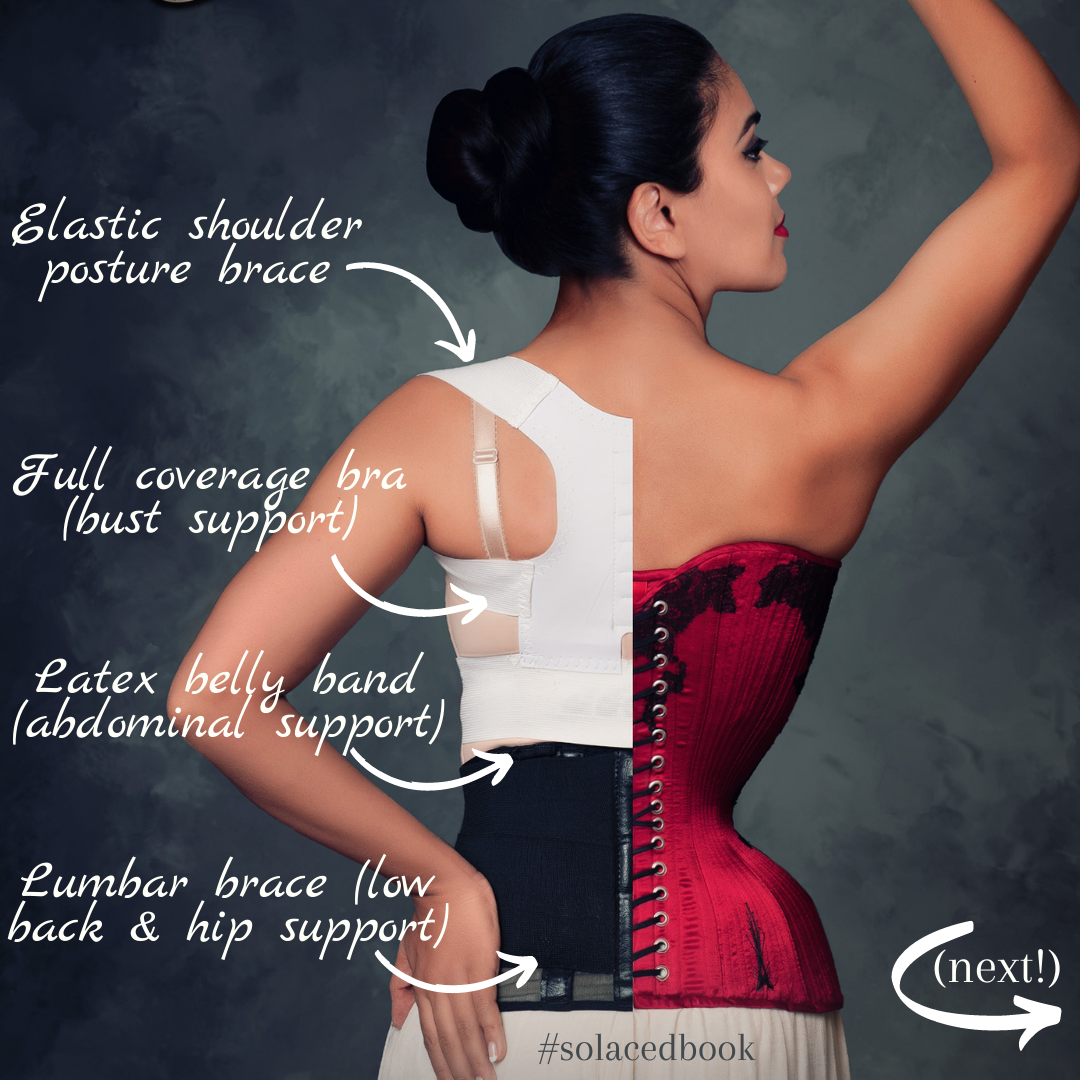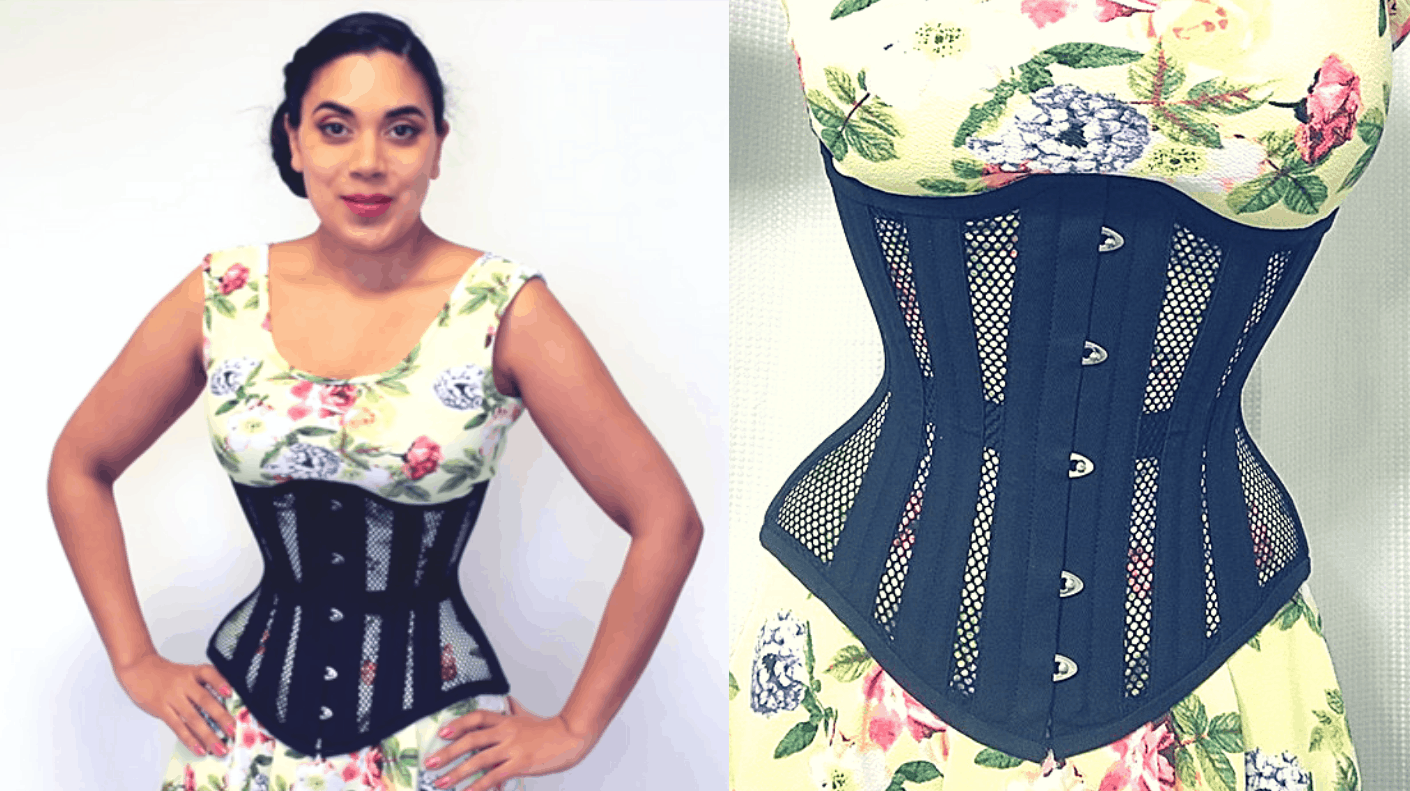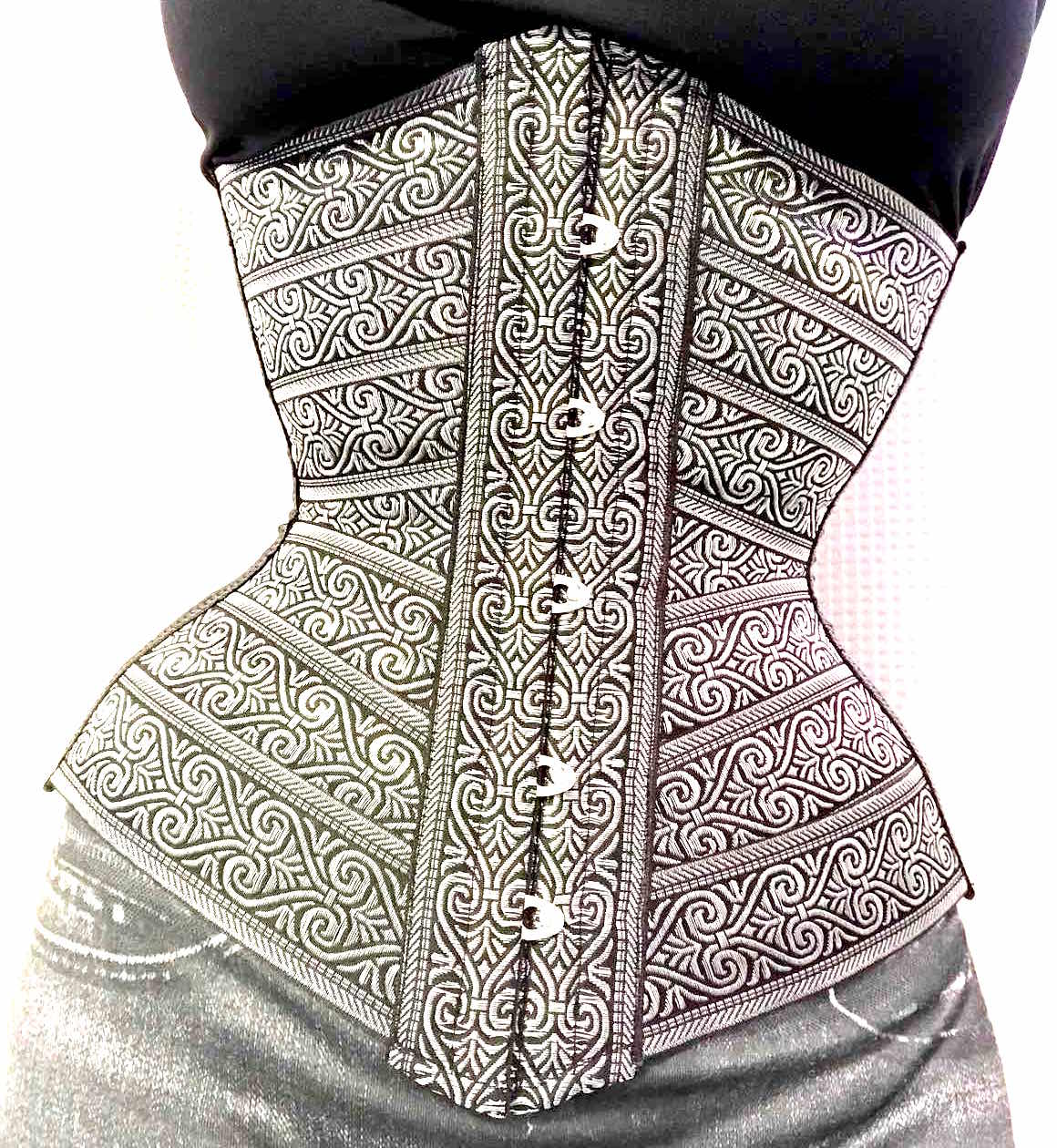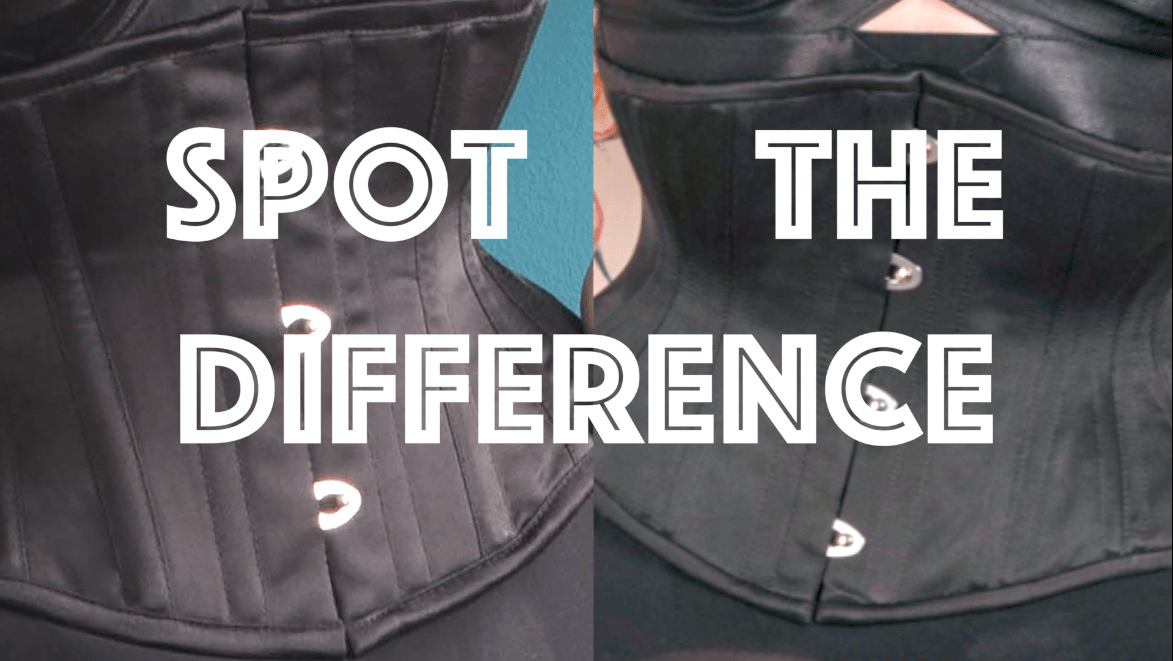
WHAT?! You just got finished reading through a dozen blog posts / watching an hour of corset videos on Youtube to figure out what length and size of corset to get, how many bones it should have, and how much to budget for your corset, and there’s still more to learn??
At the risk of overwhelming the beginners, the silhouette of a corset is what can make or break the whole experience! A corset that is ) ( shaped is often less comfortable than a corset that’s } { shaped, even though the latter seems much more dramatic to the eye, even if the two corsets have the same measurements at the top edge, waistline, and bottom edge.
When I designed the Gemini corsets in 2015, my goal was to empower wearers with a choice – round rib or conical rib? It’s up to their individual preference! However, sometimes too many options can lead to more confusion and analysis paralysis. How do you know which silhouette is right for you? I receive this question almost weekly among my prospective clients, and this list of factors is what developed from having these conversations over the past 7 years. Hopefully this list will help you decide which silhouette is better for you:
(Take the quiz to find out which style is better for you!)
Physiological factors:
Corset size
Let’s say you have a small frame, and the circumference of your floating ribs is 26 inches around if you were to look at an x-ray of yourself. But let’s also say your natural waist is closer to 40 inches, and you wear a size 32″ corset. The waistline of the corset is still 6 inches bigger than where your natural ribs sit! The corset will cinch in mostly adipose (fat) tissue and possibly some musculature, but mostly affects the squishy flesh that lies over your ribcage, while the ribs themselves might not be compressed much or at all.
However, if someone else has a larger frame but less body fat, such that their floating ribs have a lower circumference of 28 inches but they happen to wear a size 22″ corset, their ribs will have to accommodate a lot more compression. For this reason, many bigger corset wearers who have softer waistlines and wear corset sizes larger than 26″ find it easier to wear conical rib corsets compared to very lean corset wearers who wear smaller waist sizes.
Singing, public speaking, or playing a brass instrument
Singing, public speaking, and other activities which require projecting the voice, usually requires diaphragmatic breathing and a large lung capacity. Since conical rib corsets can result in more shallow breathing, speakers and performers that depend on the strength of their voice may prefer a more round rib corset.
Brass instruments strengthen the diaphragm and costal muscles in a way that singing or most woodwind instruments don’t. Blowing through a tiny aperture in order to create the “buzz” takes a lot of strength to overcome the resistance. Not only does this build up the muscles around your ribs (and more muscle tone can make your body more resistant to waist training) but also taking full, deep breaths over and over again for years during brass practice can cause your ribs to expand or flare permanently, creating a more barrel-shaped rib cage.
Woodwind instruments don’t require as much diaphragmatic strength so they typically don’t have as much resistant muscle, but they still require a large lung capacity.
Of course – if you don’t use it, you lose it – if you quit playing the tuba after middle school, you will likely lose some of that muscle tone, but a flared rib can persist. If you no longer practice a brass or woodwind instrument and your goal is to make your ribs appear more narrow, a conical corset may help with this.
Competitive sports – especially swimming
While all strenuous sports require deep breathing, competitive swimming is particularly demanding on core and back strength, as well as regulating your breathing. This goes for speed swimming as well as synchronized swimming, and even “mermaiding” and freediving (where a large lung capacity is advantageous to stay underwater for extended periods of time).
Just like with playing brass instruments, this type of exercise builds up corset-resistant muscles around the ribs, and also can eventually cause flared ribs. If you no longer swim competitively and your goal is to train your larger ribs to be more narrow, a conical corset may help with this.
Ballet and/or Pilates
Ah, finally a sport that complements corseting instead of fighting against it! Ballet and Pilates are both activities designed to contract the core and “close” the ribs. They prioritize both lean strength and flexibility of the body’s muscle groups. As conical rib corsets also “close” and taper the ribs, wearers who have previous experience with these activities may be at an advantage. Learning how to breathe with contracted ribs through sport, they may already naturally breathe in a way that’s conducive to wearing corsets. And if they have sufficient flexibility in their oblique muscles, they might find it comfortable to wear corsets.
Those who dance professionally may not want to waist train strenuously or as a lifestyle, because wearing corsets for 23 hours a day, 6-7 days a week can atrophy core muscles and work against your dance training. However, those who dance moderately or casually can also lace moderately. It’s common for corset wearers to be mistaken for dancers due to their good posture and subtle changes to their movement!
Cracked or broken ribs, past or present (childhood accidents, contact sports, etc)
This goes without saying – if you have any previous injuries to your ribs, this can cause rib sensitivity, asymmetry through the ribs, more rib rigidity (bone fractures can put you at marginally higher risk for refracture), and generally more discomfort and resistance to anything pushing down on your ribs, also known as A Bad Time when it comes to trying to wear a conical rib corset.
Interestingly, some folks with hypermobility can experience spontaneous rib dislocation, where their ribs “pop out” of place suddenly and painfully. Bioanthropologist Dr Rebecca Gibson and Kitty Krell of Crimson Rose Corsetry are two such people with H-EDS who experience this, and both wear corsets for medical purposes – a conical silhouette corset can place continuous pressure on the ribs to prevent them from popping out.
If you’ve ever had an injury to your ribs, whether it led to a broken rib or not, proceed with caution and even bring it up with your doctor before attempting to train your ribs.
Pregnancy
All sorts of interesting things happen during pregnancy (especially in third trimester). Most relevant among them: your body creates the hormone relaxin which loosens all the ligaments of your body. This is designed to widen the pelvis to allow passage of the baby during natural labor, but as the hormone doesn’t discriminate and affects every joint in your body, it can also result in side effects like one’s feet growing a shoe size – and flaring of the ribs (especially in someone with a short torso and/or large baby that pushes out on the ribs).
That’s not to say that one can’t wear a conical rib corset to train the ribs inward again, but it may take more work and more discomfort compared to someone who was never pregnant. And if you ever plan to have more kids, you can expect your ribs to flare right back out again, leading some to believe that training the ribs between pregnancies is a practice of futility. If this is you, you may be more comfortable with a round rib silhouette in the interim – at least until you’re certain you’re done having children.
Digestive issues
This is another situation where YMMV, especially in the case of IBS where one can fluctuate between constipation and diarrhea, and any number of irritants or food sensitivities can set one off. One person might be able to eat grapes and high-FODMAP fruits in a corset without bloating, another person might be able to drink milk just fine, and yet another person might be able to consume neither without debilitating pain.
Oddly enough, it’s worth mentioning that (anecdotally! Not done in any peer-reviewed study) the conical rib seems to be a more comfortable choice for people who have sensitive tummies, while the “pinchy” waist restriction of a very cupped or pipestem corset can set off acid reflux or IBS issues for some. While we could speculate as to why this happens (it may have to do with the effectiveness with which a cupped-rib corset can “divide and conquer” as Fran Blanche put it in an old article), it really seems to depend on the person.
Of course, ideally you should be in good health with regular digestion if you wish to pursue waist training at all. You will need to be monitoring your bathroom activities when you start waist training anyway.
Previous corseting experience
The body responds best to consistency. If you started with a round rib corset, it may feel easier to continue with round ribbed corsets (maybe even progressing to “rounder” and more cupped in silhouette).
Likewise, if you started with a more tapered-rib corset, you may find yourself gravitating towards more conical silhouettes (maybe even progressing to dramatically “geometric” ice-cream cone ribbed corsets).
If you’re still looking for your very first corset, the Gemini may not be the corset for you because it is specifically designed to give a very dramatic, striking silhouette, designed for advanced waist reduction. (However, if your body is naturally curvy (curvier than an hourglass) such that a Gemini might be the right beginner corset for you, continue reading through the rest of this article to determine which silhouette might be better to start with.)

Psychological factors and personal preference:
Claustrophobia
If you have claustrophobia or if you get anxious from waist restriction, the Gemini corset may not be the corset for you because it is specifically designed to be a very dramatic, striking silhouette, designed for advanced waist reduction.
However, this conversation is meant to be about silhouette in general, not necessarily waist reduction (there are more mild-reduction corsets out there that have straight ribs or rounded ribs, if you’re more of a beginner and trying to choose between them!).
If you have limited experience with corsets, any round rib style is likely to be better for those who might have claustrophobia or anxiety around corseting. A round rib Gemini corset has the ability to place pressure primarily at the waistline, and little to no pressure on the ribs and hips, so it can feel more like a narrow training belt (while still looking stunning).
YMMV though, as some folks like the narrow band of pressure, while others find it unnerving and would much rather have the smooth, gradual (for lack of a better word) gradient of pressure that comes with a conical rib, even though it results in more compression overall. As with all things that affect your psyche, it’s very much subjective and up to individual preference.
Your main purpose or goal for wearing a corset
Different tissues and systems of the body have different levels of difficulty when it comes to waist training. As we mentioned under #1, fat (adipose) tissue is the softest and compresses readily by corsets (although it also tends to bounce back easily, and so it’s more difficult to see long-term results if you’re compressing primarily adipose tissue).
Oblique muscles take time to first stretch and then ‘mold’ to the shape of a corset (can take many months). Bones take the longest time as it requires your costal joints to become more flexible, and for very advanced (lifestyle) corseters, there’s even an element of bone remodeling over years! So if your main goal is long-term waist training to make your natural waist smaller (semi)permanently, then the conical rib will be more effective in achieving this.
If however your goal is for a temporary but dramatic-as-possible tightlaced silhouette, the round rib may be the better choice.
If you are looking for a gentle hug of a corset for back support and pain relief, going for a gently tapered silhouette in a mild waist reduction will be better than swinging too dramatically on either end of the spectrum (too conical can hurt one’s ribs, and too cupped can hurt one’s lower back if it’s not well fitted to your body or experience level).
Your aesthetic preference (and taste in historical clothing)
Most historical corsets have a more tapered rib, from the very straight Elizabethan bodies, to the smoothly tapered Victorian corsets, and the even slightly more conical Edwardian S-curve corsets. The very conical silhouette of the straight-ribbed Gemini lends itself particularly well under 1940s and 1950s Dior New Look retro style clothing.
On the other hand, when corset enthusiasts speak of anatomically correct / anatomically patterned corsets, they are typically talking about more round-ribbed and convex-hipped corsets which gently cup and support the rigid areas of the skeletal frame, while only compressing the soft areas of the body (the squishy waistline). If this is your preference, and if you like “stealthing” under modern clothing, the round rib may be more to your liking.
What additional factors, if any, would you add to this list? Do you personally prefer round rib or conical rib corsets? Leave a comment below!













































